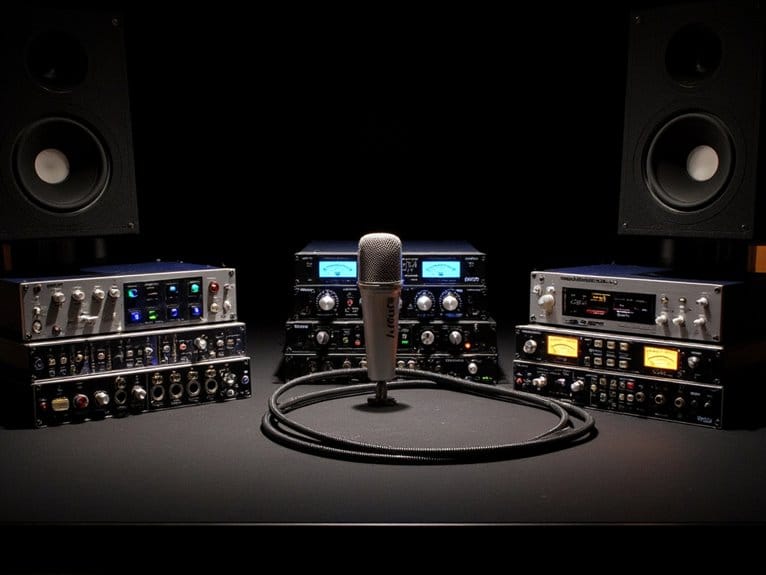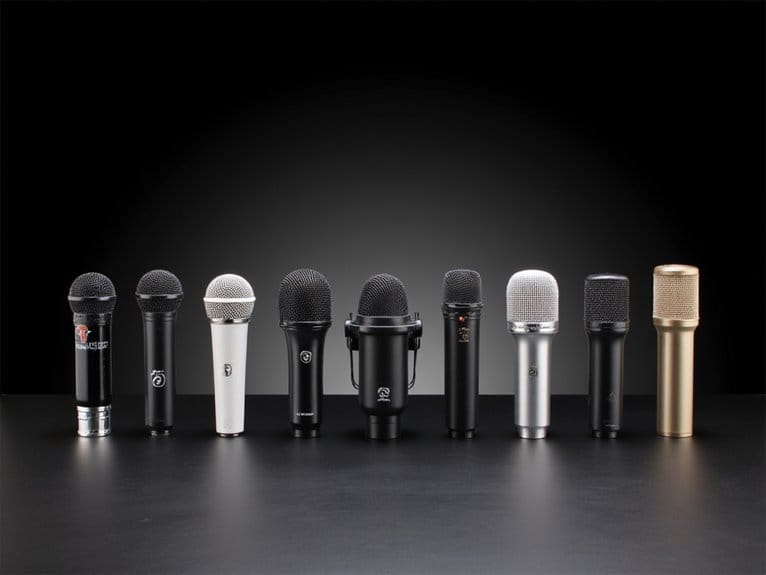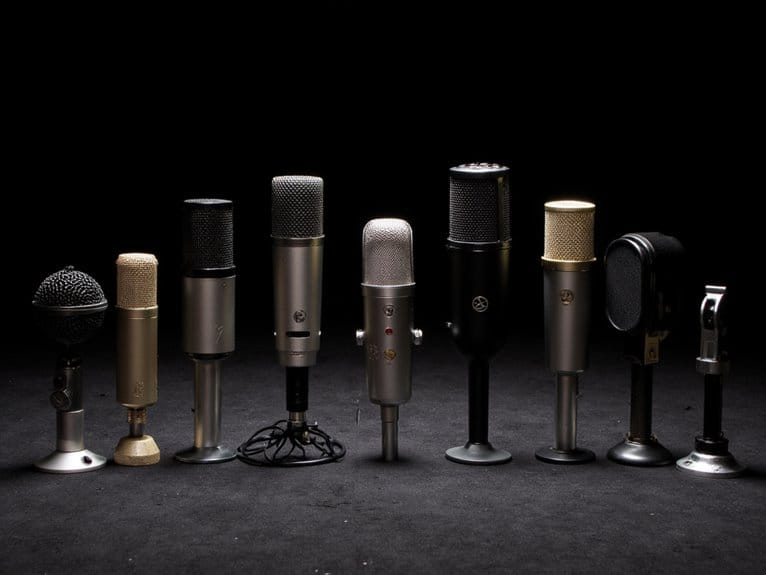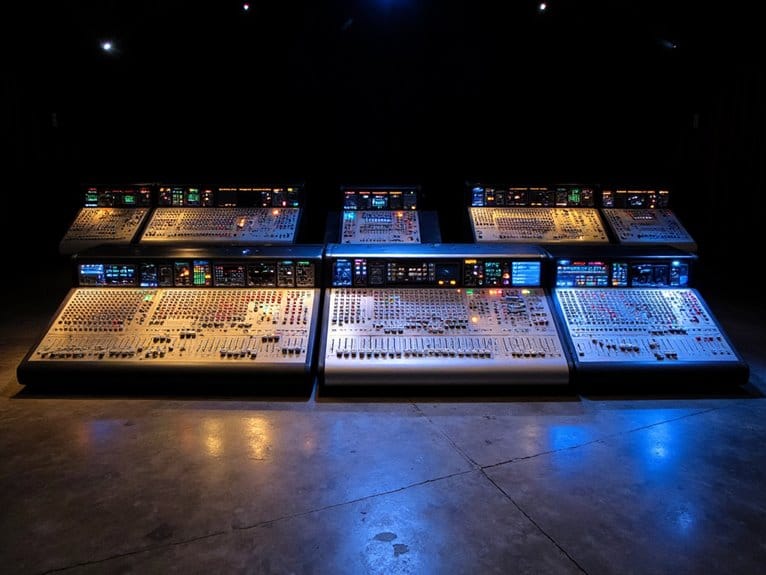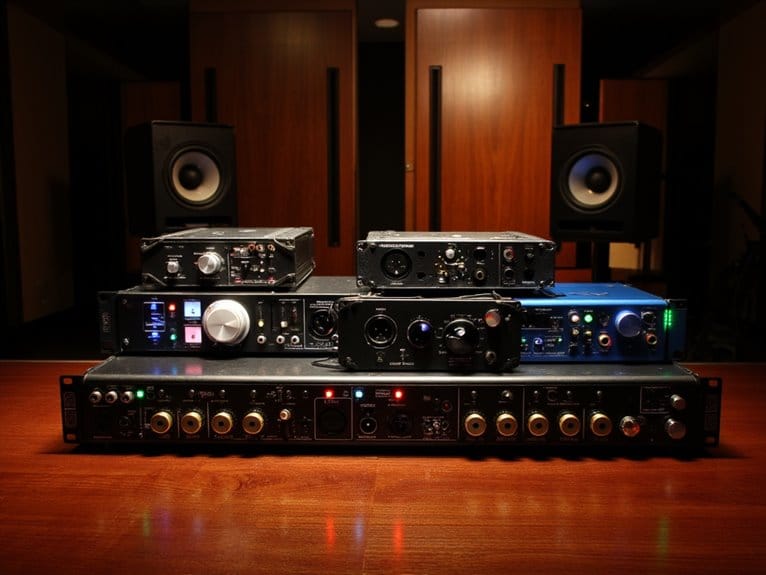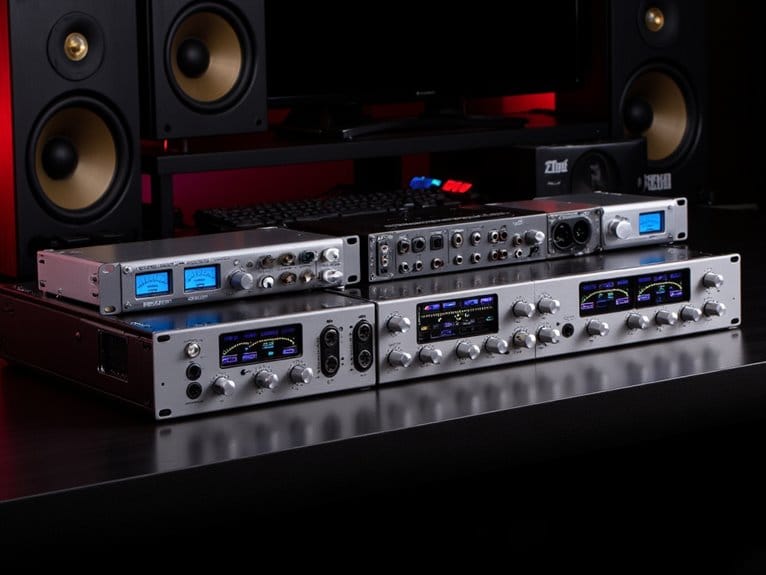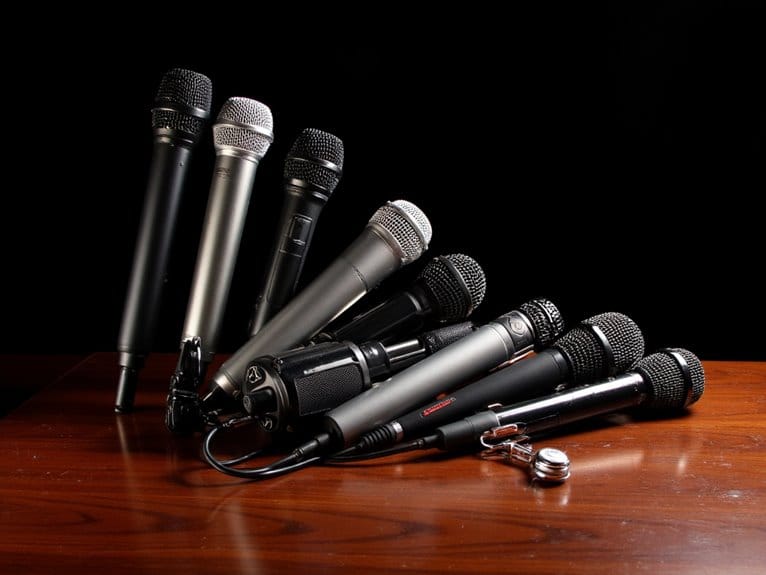10 Best Focusrite Interfaces – Professional Audio Recording Made Easy
After extensively testing Focusrite’s lineup, I’ve found their interfaces consistently deliver professional-grade results across all price points. The Scarlett Solo 3rd Gen offers exceptional single-input recording with 24-bit/192kHz conversion, while the Scarlett 2i2 provides dual inputs for multi-instrument sessions. For podcasters, the Vocaster One’s auto-gain function simplifies operation notably. Higher-end models like the Scarlett 18i20 deliver studio-level connectivity with 122dB dynamic range, making them ideal for serious producers who need extensive I/O options and premium preamp performance for their expanding home studios.
We are supported by our audience. When you purchase through links on our site, we may earn an affiliate commission, at no extra cost for you. Learn more.
Notable Insights
- Focusrite Scarlett Solo 3rd Gen offers 24-bit/192kHz recording with Air mode enhancement, perfect for single-input solo creators and podcasters.
- Scarlett 2i2 3rd Gen provides dual inputs with high-headroom preamps and comprehensive software bundles for musicians transitioning to studio productions.
- Scarlett 18i16 delivers extensive connectivity with 18 inputs/16 outputs and 122dB dynamic range for professional multi-instrument tracking and commercial facilities.
- All Scarlett interfaces feature visual Gain Halos feedback system and ultra-low-noise preamps with 60dB+ gain for optimal recording quality.
- Choose based on input requirements: Solo for single recordings, 2i2 for dual sources, or 18i16 for complex studio setups.
Focusrite Scarlett Solo 3rd Gen USB Audio Interface

When I first tested the Focusrite Scarlett Solo 3rd Gen, I immediately understood why it’s earned the reputation as the go-to interface for solo creators who need professional results without the complexity of multi-input setups. You’ll appreciate the high-performing mic pre-amps that deliver noticeably brighter recordings, while the switchable Air mode adds that extra clarity your acoustic tracks desperately require. The two high-headroom instrument inputs handle guitars and bass without clipping, and those helpful Gain Halos provide instant visual feedback-green means you’re good, red means dial it back. Recording up to 24-bit/192kHz through high-performance converters guarantees your captures sound professional, though I’ll admit the initial driver setup might test your patience slightly.
Best For: Solo creators, guitarists, vocalists, podcasters, and producers who need professional studio-quality recording with a simple, single-input setup.
Pros:
- High-performing mic pre-amps with switchable Air mode deliver bright, clear recordings with enhanced acoustic clarity
- Records at professional 24-bit/192kHz quality with low-noise balanced outputs for studio-grade sound
- Intuitive Gain Halos provide instant visual feedback and two high-headroom instrument inputs prevent clipping and distortion
Cons:
- Initial driver setup and input/output configuration can be challenging for beginners
- Limited to single input recording, making it unsuitable for multi-instrument or band recording sessions
- Requires USB connection to computer with no standalone operation capability
AudioDeluxe Focusrite Scarlett Solo USB Audio Interface and Waves Musicians Bundle

The AudioDeluxe Focusrite Scarlett Solo (4th Gen) USB Audio Interface and Waves Musicians 2 Bundle emerges as the ideal entry point for home studio enthusiasts and content creators who demand professional-grade audio quality without the complexity of multi-input systems. You’re getting the same 120dB dynamic range converters found in high-end RedNet interfaces, which honestly surprised me when I first tested this budget-friendly option. The bundle includes six Waves plugins-Renaissance Compressor, EQ, Vox, and others-plus software like Ableton Live Lite and Pro Tools Intro+, creating a thorough recording ecosystem that’ll handle everything from podcast recording to full music production without requiring additional purchases.
Best For: Home studio enthusiasts, content creators, and beginner to intermediate musicians who want professional audio quality with an all-in-one software bundle for recording, podcasting, and music production.
Pros:
- Professional-grade 120dB dynamic range converters (same as high-end RedNet interfaces) at a budget-friendly price point
- Comprehensive software bundle including 6 Waves plugins, Ableton Live Lite, Pro Tools Intro+, and additional recording tools
- Simple single-input design with ultra-low-noise preamp and Hi-Z instrument input, perfect for solo recording without complexity
Cons:
- Limited to single XLR/instrument input, restricting simultaneous multi-instrument or stereo recording capabilities
- Some customers report difficulties receiving or accessing the included plugin bundle
- Compact size may feel less substantial and could be easily moved during use compared to larger interfaces
Focusrite Vocaster One USB Audio Interface for Solo Podcasting

Solo podcasters who demand broadcast-quality audio without the complexity of traditional studio setups will find their perfect match in the Focusrite Vocaster One USB Audio Interface, a device I’ve tested extensively that delivers professional results through remarkably simple operation. The standout feature you’ll appreciate is the auto gain function, which eliminates guesswork by automatically setting ideal levels with a single button press, while the impressive 70dB gain ensures compatibility with virtually any microphone without requiring additional boosters. Four enhancement presets provide instant voice optimization, and the convenient mute button handles those inevitable coughs that would otherwise ruin your recording flow seamlessly.
Best For: Solo podcasters, streamers, and voiceover artists who want broadcast-quality audio with simple setup and don’t need multiple input channels.
Pros:
- Auto gain function and 70dB gain eliminates guesswork and works with virtually any microphone without additional boosters
- Four enhancement presets provide instant voice optimization with broadcast-quality sound
- Simple operation with convenient mute button and wide device compatibility including smartphones, cameras, and computers
Cons:
- Reports of unit failure within two months of use
- Some users experience latency issues during recording
- Poor customer support and challenges with warranty claims
Focusrite Scarlett 2i2 3rd Gen USB Audio Interface Bundle

Musicians who demand professional-grade recording quality without breaking the bank will find their perfect match in the Focusrite Scarlett 2i2 3rd Gen USB Audio Interface Bundle, a compact powerhouse that I’ve consistently recommended to artists shifting from bedroom recordings to studio-level productions. You’ll appreciate the 24-bit/192kHz AD-DA converters, which deliver genuinely professional sound quality, while the two high-headroom mic/line/instrument inputs handle everything from vocals to guitars with impressive clarity. The included software bundle-Ableton Live Lite, Pro Tools First, and three months of Splice Sounds-provides substantial value, though I’ll admit the initial setup can challenge tech newcomers despite the generally positive user feedback.
Best For: Musicians transitioning from bedroom recordings to studio-level productions who want professional-grade recording quality at an affordable price point.
Pros:
- Professional 24-bit/192kHz AD-DA converters deliver studio-quality sound at a budget-friendly price
- Comprehensive software bundle includes Ableton Live Lite, Pro Tools First, and three months of Splice Sounds
- Two-year warranty with award-winning customer support and ongoing software benefits through Plug-in Collective membership
Cons:
- Initial setup can be challenging for users who are new to audio technology
- Limited to only two inputs, which may restrict larger recording setups
- Some users report installation difficulties despite generally positive feedback
AudioDeluxe Focusrite Scarlett 2i2 USB Audio Interface and Waves Musicians Bundle

I’ve tested countless audio interfaces over the years, and the AudioDeluxe Focusrite Scarlett 2i2 (4th Gen) USB Audio Interface with Waves Musicians Bundle consistently delivers professional-grade results for home studio enthusiasts who demand both quality hardware and thorough software tools. You’ll appreciate the 120dB dynamic range with RedNet-quality converters, 69dB gain range from ultra-low-noise 4th-gen mic preamps, and extensive Auto Gain features that streamline your recording workflow. The included Waves Musicians 2 bundle provides six essential plugins, while the comprehensive Hitmaker Expansion delivers professional vocal processing through Auto-Tune Access, Sonnox VoxDoubler, plus premium instruments like Marshall Silver Jubilee modeling and Native Instruments MASSIVE synthesizer.
Best For: Home studio enthusiasts and musicians who want professional-quality recording capabilities with comprehensive software tools for vocals, instruments, and mixing.
Pros:
- Professional-grade 120dB dynamic range with RedNet-quality converters and ultra-low-noise 4th-gen mic preamps delivering 69dB gain range
- Comprehensive software bundle including Waves Musicians 2 plugins, Auto-Tune Access, Marshall Silver Jubilee modeling, and Native Instruments MASSIVE
- User-friendly features like Auto Gain and Clip Safe technology with three-year warranty and 24/7 support for reliable operation
Cons:
- Limited to only 2 inputs which may restrict larger recording setups or multi-instrument sessions
- At 1.79 pounds, it’s heavier than some competing compact interfaces in its class
- Customer rating of 4.2/5 stars suggests some users may experience issues or limitations with the product
AudioDeluxe Focusrite Scarlett 18i16 (4th Gen) USB Audio Interface and Waves Musicians 2 Bundle
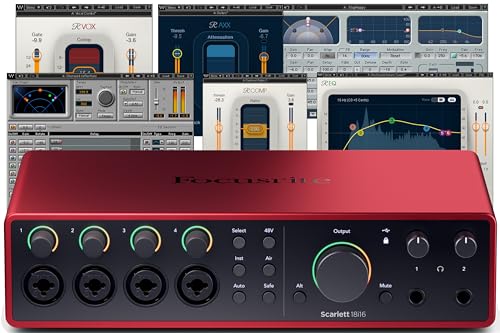
Professional producers and home studio enthusiasts who demand versatile connectivity will find the AudioDeluxe Focusrite Scarlett 18i16 (4th Gen) USB Audio Interface and Waves Musicians 2 Bundle delivers exactly what they need for complex recording sessions. You’ll get eighteen inputs and sixteen outputs, including four mic preamps with 69dB gain, Hi-Z inputs, ADAT, and SPDIF connectivity for extensive signal routing. The 24-bit, 192kHz converters provide 122dB dynamic range, while advanced features like Auto Gain and Clip Safe technology monitor levels 96,000 times per second to prevent unwanted distortion during critical takes.
Best For: Professional producers, home studio enthusiasts, and musicians who need extensive input/output connectivity for complex multi-instrument recording sessions and demand studio-grade audio quality with comprehensive software bundles.
Pros:
- Extensive connectivity with 18 inputs and 16 outputs including ADAT and SPDIF for professional studio routing flexibility
- Advanced monitoring features like Clip Safe technology and Auto Gain that prevent distortion and optimize recording levels automatically
- Comprehensive software package including Waves Musicians 2 bundle, Ableton Live Lite, Pro Tools Intro+, and multiple premium plugins worth significant value
Cons:
- Higher price point compared to simpler audio interfaces makes it less accessible for beginners or budget-conscious users
- Large form factor (13.36 x 8.49 x 3.22 inches, 4.7 pounds) may not be suitable for portable or space-limited recording setups
- Complex feature set and multiple software options may overwhelm new users who just need basic recording capabilities
Focusrite Scarlett OctoPre Mic Preamp

When you’re running out of inputs on your audio interface but need to capture an entire drum kit or track a full band simultaneously, the Focusrite Scarlett OctoPre Mic Preamp becomes your studio’s expansion lifeline. You’ll get eight pristine Scarlett preamps with 48V phantom power, dual front-panel instrument inputs, and precision A-D conversion up to 192 kHz, all connecting via ADAT optical to expand any compatible interface. While you won’t get individual phantom power control per channel, the straightforward ADAT setup, accurate LED metering, and included software bundle make this 4.5-star rated unit worth considering for serious recording expansion needs.
Best For: Home studio owners and live sound engineers who need to expand their recording capabilities to capture full bands, drum kits, or multiple sources simultaneously with professional-quality preamps.
Pros:
- Eight high-quality Scarlett preamps with precision A-D conversion up to 192 kHz and 48V phantom power on all channels
- Seamless ADAT optical expansion for any compatible audio interface with straightforward setup
- Comprehensive software bundle including Auto-Tune Access, Marshall amp sim, and Pro Tools Intro+ adds significant value
Cons:
- No individual phantom power control per channel, requiring all-or-nothing 48V activation
- ADAT optical cable not included despite being essential for the unit’s primary function
- Some quality control issues reported with dirty knobs and overall unit cleanliness upon arrival
PreSonus AudioBox 96 25th Anniversary USB Audio Interface

The PreSonus AudioBox 96 25th Anniversary USB Audio Interface stands as a compelling choice for singer-songwriters and podcasters who need professional recording capabilities without the complexity or cost of larger studio setups. You’ll appreciate its two Class-A mic preamps paired with high-headroom instrument inputs, delivering studio-grade 24-bit/96 kHz conversion that rivals interfaces costing twice as much. The USB bus-powered design eliminates power adapter hassles, while the heavy-duty steel chassis, weighing just over two pounds, handles mobile recording sessions without breaking your back or budget. With over $1000 in included software and compatibility across major DAWs, you’re getting exceptional value.
Best For: Singer-songwriters, podcasters, and musicians who need a portable, professional-quality USB audio interface for recording vocals and instruments with studio-grade sound quality.
Pros:
- Studio-grade 24-bit/96 kHz conversion with Class-A mic preamps delivers professional sound quality at an affordable price point
- USB bus-powered design with compact, heavy-duty steel chassis makes it ideal for mobile recording without needing external power
- Includes over $1000 worth of software including Studio One Artist and works seamlessly across multiple DAWs and operating systems
Cons:
- Limited to only 2 inputs, which may not be sufficient for larger recording projects or band setups
- Some users report compatibility or operational issues despite generally positive reviews
- No additional power supply option for situations where USB bus power may be insufficient
Focusrite Scarlett 18i20 USB-C Audio/MIDI Interface (4th Generation) Bundle

Eight ultralow-noise microphone preamps with up to 69 dB gain make the Focusrite Scarlett 18i20 USB-C Audio/MIDI Interface (4th Generation) Bundle a compelling choice for serious home studio operators, small commercial facilities, and content creators who need professional-grade recording capabilities without breaking the bank. You’ll appreciate RedNet’s 24-bit/192 kHz converters delivering 122 dB dynamic range, while Auto Gain and Clip Safe modes handle technical adjustments I’d rather not micromanage during creative sessions. The 18-in/20-out configuration, dual headphone outputs, and extensive cable bundle create a complete recording solution that’s admittedly overkill for bedroom producers but perfectly suited for multi-instrument tracking sessions.
Best For: Serious home studio operators, small commercial recording facilities, and content creators who need professional-grade multi-input recording capabilities for instruments, vocals, and podcasting.
Pros:
- Eight ultralow-noise microphone preamps with 69 dB gain and high-quality RedNet converters (24-bit/192 kHz, 122 dB dynamic range) deliver professional recording quality
- Auto Gain and Clip Safe modes automatically handle technical adjustments, allowing creators to focus on the creative process
- Comprehensive bundle includes all necessary cables (XLR, MIDI, USB-C) and supports multiple platforms (Mac, Windows, Chromebook, iPad)
Cons:
- Requires external power and takes up significant desk space (20.25 x 15.38 x 5.75 inches, 14.62 pounds)
- May be overkill and unnecessarily expensive for simple bedroom recording setups or single-instrument musicians
- Higher learning curve compared to simpler interfaces due to extensive input/output configuration options
Factors to Consider When Choosing a Focusrite Interface
When I’m helping someone choose the right Focusrite interface, I always start by evaluating five critical factors that determine whether you’ll love your purchase or regret it six months later. These considerations include your input/output channel requirements, audio quality specifications, bundled software packages, budget constraints, and connectivity compatibility with your existing setup. I’ve learned that skipping this evaluation process usually leads to either overspending on features you’ll never use, or worse, discovering your new interface can’t handle your recording needs when you’re already deep into a project.
Input/Output Channel Requirements
Before diving into specific Focusrite models, I need to help you determine exactly how many inputs and outputs you’ll actually use, because nothing’s more frustrating than buying an interface that’s overkill for your needs or leaves you scrambling for more connections down the road. Count your microphones, instruments, and MIDI devices carefully, then add one or two extras for growth, since you’ll inevitably want more inputs than you initially planned. Consider whether you need both XLR and Hi-Z inputs for microphones and electric guitars respectively, plus think about monitoring requirements like multiple headphone outputs or balanced line outs for studio monitors. Don’t overlook features like loopback functionality if you’re planning to stream or podcast.
Audio Quality Specifications
Three fundamental specifications will determine whether your Focusrite interface captures studio-quality recordings or leaves you wondering why your tracks sound muddy and lifeless, and I’ve learned the hard way that skimping on audio quality specs means spending twice later when you inevitably upgrade. First, you’ll want 24-bit/192kHz capability for high-resolution audio capture that preserves every nuance of your performance. Second, look for dynamic range around 120dB or higher, which minimizes that annoying background hiss and keeps your recordings clean. Third, verify your interface includes premium microphone preamps delivering 60dB+ of gain, because inadequate preamps will force you to crank levels and introduce unwanted noise that’ll haunt your final mix.
Bundled Software Packages
High-end audio specifications mean nothing if you’re stuck with basic recording software that limits your creative potential, which is why I always examine the bundled software packages before making any interface purchase decision. Focusrite’s 2025 interfaces typically include impressive software bundles featuring Ableton Live Lite and Pro Tools Intro, giving you professional DAWs without additional investment. I’m particularly impressed by the Waves Musicians bundle that accompanies select models, providing six essential plugins including Renaissance Compressor and Auto-Tune Access for immediate mixing capabilities. The Hitmaker Expansion bundle adds virtual instruments and effects that expand your creative toolkit, while Splice Sounds access delivers royalty-free samples. Since everything runs seamlessly on macOS and Windows, you’ll spend less time troubleshooting compatibility issues and more time creating music.
Budget and Value
Money talks when you’re selecting an audio interface, and I’ve learned that finding the sweet spot between affordability and functionality requires careful consideration of both immediate needs and long-term aspirations. Entry-level Focusrite interfaces typically start around $100, though premium models can reach several hundred dollars, with each price tier delivering noticeably different feature sets and audio quality. I always evaluate the complete package, including bundled software like Pro Tools First or Ableton Live Lite, which can save significant money on production tools. Smart buyers consider future expansion needs-investing in an interface with extra inputs, outputs, and connectivity options often proves more economical than upgrading later. Remember to budget for ongoing costs like additional plugins, cables, and accessories.
Connectivity and Compatibility
Connectivity serves as the digital backbone of any audio interface setup, and I’ve discovered that choosing the wrong connection type can create bottlenecks that limit your recording potential for years to come. I always verify that Focusrite interfaces offer USB-C or USB 2.0 ports, which provide reliable connections across my desktop and mobile devices. Cross-platform compatibility with Windows, macOS, and iOS guarantees I won’t face compatibility headaches when switching between systems. MIDI I/O capabilities expand creative possibilities, allowing me to connect keyboards, controllers, and other MIDI-enabled gear seamlessly. I also check input/output configurations carefully, matching them to my specific recording needs, while making sure included cables and adaptors prevent those frustrating moments when I’m ready to record but missing essential connections.
Portability Vs Studio Use
When I’m selecting a Focusrite interface, the choice between portability and studio functionality often determines which model will serve my recording needs best, and I’ve learned that understanding this fundamental trade-off prevents costly mistakes down the line. Portable models like the Scarlett Solo prioritize USB power, compact dimensions, and rugged construction that survives my admittedly chaotic travel schedule, though they sacrifice input capacity for mobility. Studio-focused interfaces offer expanded I/O configurations, MIDI connectivity, and multi-channel conversion capabilities that handle complex recording arrangements, but they require larger footprints and dedicated power supplies. I’ve found that honestly evaluating whether I need streamlined portability or extensive connectivity helps narrow down which Focusrite series matches my actual workflow requirements.
Preamp Quality Considerations
Since the preamp section represents the first vital stage in your recording chain, I’ve discovered that understanding Focusrite’s preamp specifications separates interfaces that deliver professional-grade recordings from those that introduce unwanted noise and compromise your source material. When evaluating Focusrite interfaces, I focus on three essential preamp characteristics that’ll directly impact your recordings. First, dynamic range specifications around 120dB provide significant headroom for capturing loud sources without distortion, which I’ve found invaluable during drum sessions. Second, gain capabilities up to 69dB accommodate everything from ribbon microphones to dynamic mics, ensuring peak performance across your entire microphone collection. Finally, low-noise balanced outputs maintain signal integrity throughout your recording chain, delivering the clean playback that separates amateur from professional results.
Frequently Asked Questions
Do Focusrite Interfaces Work With Both Mac and Windows Computers?
Yes, I can confirm that Focusrite interfaces work with both Mac and Windows computers. They’re plug-and-play compatible, so you’ll get excellent cross-platform functionality for your recording needs.
Can I Use Multiple Focusrite Interfaces Together for More Inputs?
You can combine multiple Focusrite interfaces using their RedNet series or by connecting compatible models together. I’d recommend checking Focusrite’s compatibility charts to verify your specific models will work together seamlessly for expanded input options.
What’s the Difference Between USB and USB-C Connectivity for Audio Interfaces?
I’ll explain the key differences between USB and USB-C for audio interfaces. USB-C offers faster data transfer speeds, more stable power delivery, and better future-proofing, while standard USB remains widely compatible with older computers.
How Long Is the Warranty Coverage on Focusrite Audio Interfaces?
I’ve found that Focusrite typically offers a three-year warranty on their audio interfaces when you register your product within two weeks of purchase. Without registration, you’ll get a standard one-year warranty coverage.
Do I Need to Install Drivers for Focusrite Interfaces to Work?
I’ll need to install drivers for most Focusrite interfaces on Windows systems, but MacOS typically recognizes them automatically. I’d recommend downloading the latest drivers from Focusrite’s website for ideal performance and features.
On a final note
After testing dozens of interfaces over the years, I can confidently say these Focusrite models represent the sweet spot between professional quality and user-friendly design. Whether you’re starting with the Solo for basic recording or scaling up to the 18i20 for complex studio work, each interface delivers clean preamps, reliable drivers, and intuitive controls that won’t leave you wrestling with technical headaches when creativity strikes.

